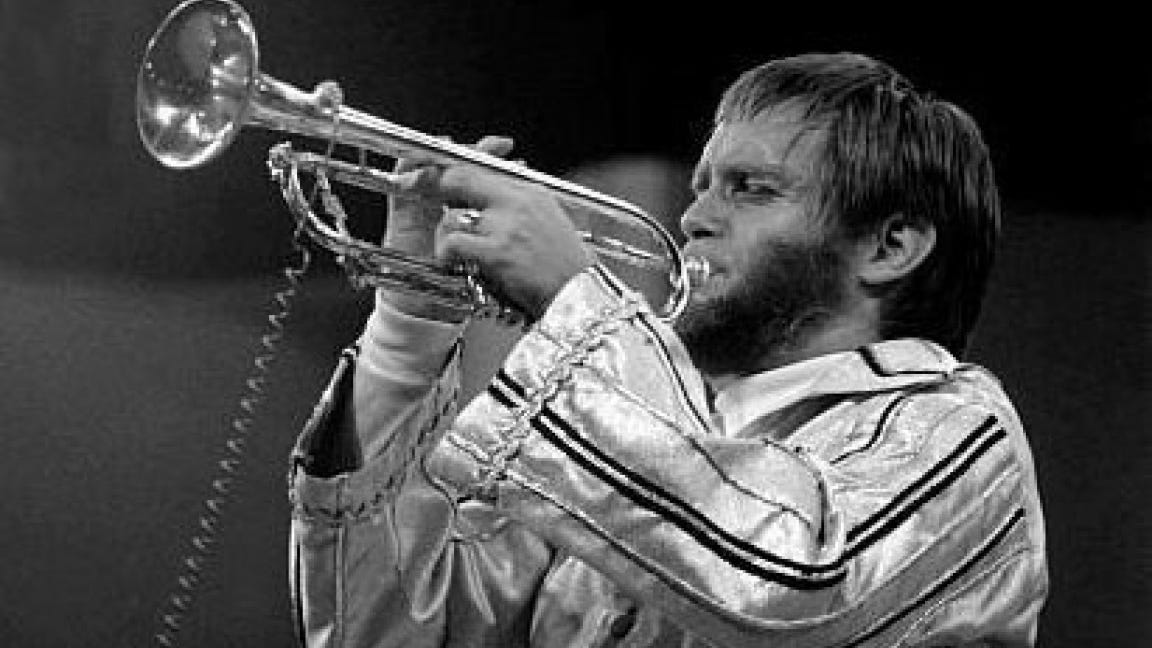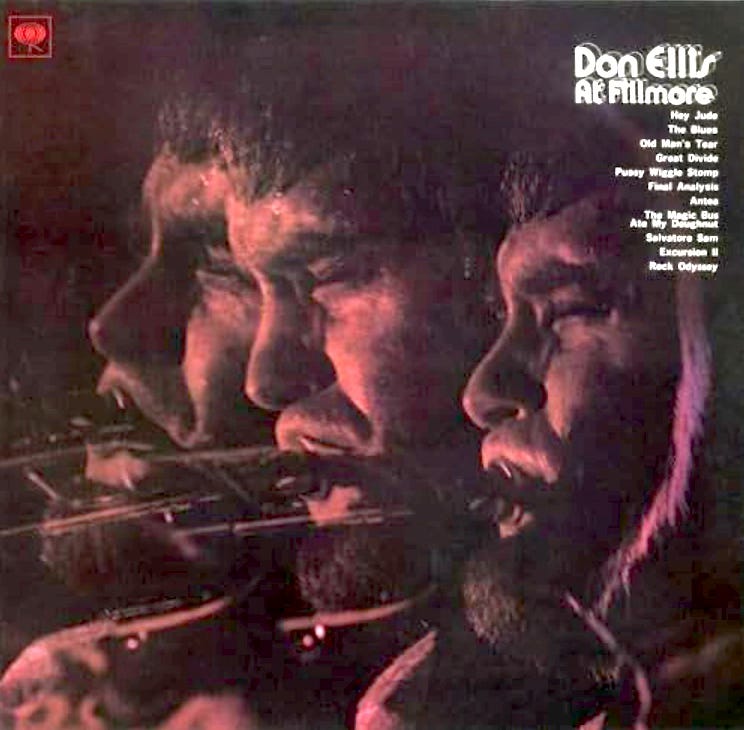By the time Don Ellis blew his last note in 1978, the trumpet was still smoking. You don’t just play music like Ellis did—you rip it from the walls of the concert hall and rebuild it in your own mad image, like some demented architect of polyrhythmic Babylon. And Ellis wasn’t content with simply nudging jazz forward. He wanted to detonate the whole genre, then dance barefoot on the rubble while counting in 19/8.
This wasn’t just jazz. This was rhythmic brinkmanship. Harmonic sacrilege. A sonic coup d’état.
Born in 1934 in Los Angeles, Don Ellis was a straight-A student of tradition—until he realized tradition was boring as hell. After stints with the big bands of Ray McKinley and Maynard Ferguson, he landed in the crucible of experimentation: the George Russell Orchestra. That’s where the virus took hold. He caught the asymmetrical fever. He looked at 4/4 time and saw a cage. So he picked the lock.
Ellis wasn’t trying to be different for the sake of it. He was possessed. Obsessed. He studied Indian music like it was the Rosetta Stone. Took a scalpel to Western harmony. Wrote compositions that looked like math homework from an alien race.
Then he made it all swing.
Let’s get something straight—Don Ellis didn’t just dabble in odd meters. He made them his gospel. He wasn’t counting off “one-two-three-four.” He was whispering arcane spells: “three-three-two-two-two-one-two-two-two.” That’s the count for “33 222-1-222.” Try tapping your foot to that and see what kind of seizure you induce.
Ellis’s charts were rhythmic obstacle courses. Musicians had to be Olympic-level freaks to survive. But they did more than survive—they grooved. There’s something deranged and beautiful about watching a 21-piece orchestra lock into 19/8 and make it sound like a Motown jam. The drums clatter like a thousand caffeinated gods. The horns scream. The bass slithers in the shadows, syncing to a beat you didn’t know your body could feel.
You don’t dance to this music. You submit to it. You let it scramble your inner metronome and rewire your nervous system.
Most trumpet players were content with three valves. Not Ellis. He slapped on a fourth valve so he could play quarter-tones—those slippery little bastards between the notes. It was like hearing a ghost whisper from inside a melody.
He wasn’t afraid of technology, either. Before Miles ever plugged in, Ellis was playing through echoplexes, ring modulators, and phase shifters, bending time and tone like Dali on acid. His trumpet sounded like a spaceship suffering a religious experience.
He didn’t just want you to hear the trumpet. He wanted it to haunt your dreams.
Ellis’s band was a circus of sound: sitars, electric violins, multiple drum kits, and tablas throwing down with jazz traps like they were fighting over a holy rhythm. On Electric Bath—his 1968 masterpiece—he fuses psychedelic freakouts with Ellingtonian swing, acid rock fuzz with Bollywood flair. It’s like Coltrane dropped acid and started a marching band in outer space.
By the early 1970s, Hollywood came knocking—and Ellis answered with a bullhorn and a bag of grenades. His score for The French Connection (1971) didn’t get Academy Award recognition, but it rewrote the rules for action movie soundtracks. That screeching, paranoid brass? That manic tempo that feels like you’re running downhill toward death? That’s Don Ellis.
Listen to the Theme from the French Connection:
You know the car chase scene—the one every other action movie tries to rip off? That’s Ellis’s jazz-charged heartbeat under the hood. His music doesn’t accompany the film—it attacks it. It snarls. It stalks. It drags you down into the sewer and dares you to climb out.
Then came The Seven-Ups (1973), another gritty cop drama with Ellis’s sonic fingerprints all over it, and another incredible car chase. Funk, jazz, paranoia, urban decay—it’s all there in the score, lurking in the rhythm section, pouncing through the horns.
He even dipped into television. Ever seen Brannigan with John Wayne? The music was tighter than Wayne’s toupee. Ellis managed to inject jazz into places where it had no right to be, and made it sound like it had always belonged.
Ellis wasn’t just a wild-eyed composer with a thing for odd meters. He was a theorist, a teacher, a brass-shaman whose classroom had more time signatures than chairs. His book Quarter Tones was a bible for brass lunatics who wanted to blow notes between the cracks.
He taught workshops, led clinics, and freaked out music students who thought jazz was just about swing and standards. To Ellis, jazz was a verb. A living beast. You didn’t study it. You wrestled it into submission.
His students? Many became pioneers themselves—some in jazz, others in film and television, some likely in psychiatric therapy after surviving a semester of Ellis rhythm drills.
Let’s talk about the band.
The Don Ellis Orchestra wasn’t a jazz group. It was a battalion of sound. A tactical assault unit of syncopation. Trumpets, trombones, strings, electric bass, keyboards, ethnic percussion from three continents, and more drummers than a Haitian carnival.
Live, they were explosive. They’d open with something like “Pussy Wiggle Stomp” (yes, that’s a real song title), and within two minutes, the audience would be in rhythmic shock. By minute six, their souls had left their bodies.
Ellis didn’t conduct so much as ignite. He’d flail like a man possessed, eyes wide, sweat flying, trumpet screaming. He looked like he was trying to physically restrain the music from tearing the walls down.
And sometimes, he failed. Gloriously.
Don Ellis had a heart that beat too fast—literally. His arrhythmia was well-known. Irony? Perhaps. Cosmic joke? More likely.
By 1978, he was still pushing, still innovating, still convincing musicians to count in 11-and-a-half. But his heart couldn’t keep up. At just 44 years old, Don Ellis dropped dead of a heart attack. The rhythm finally got him.
He left behind a crater where the rules used to be.
What do you do after Don Ellis?
You get Weather Report. You get Mahavishnu. You get Frank Zappa writing charts in 13/8 and smirking the whole time.
You get film composers like Lalo Schifrin, Jerry Goldsmith, and even Hans Zimmer exploring dissonance, asymmetry, and texture with Ellis’s ghost humming in their ears.
But more than anything, you get freedom. Don Ellis showed that jazz could be anything—tribal, futuristic, mathematical, emotional. That it didn’t need to sit politely in a club or swing like it was 1955. It could scream, shimmer, stumble, fly.
Don Ellis was a sonic anarchist in a world of jazz bureaucrats. He didn’t want your approval. He wanted your attention. He was the guy who painted the Sistine Chapel, then set it on fire to see what the smoke would sound like.
There’s a quote floating around in jazz circles: “The real innovators are never understood until after the funeral.” Ellis didn’t just prove it. He orchestrated it. Scored it in 27/16, with a tabla breakdown and a trumpet solo that bends light.
So next time you hear a band stretch beyond 4/4, dip into chaos, or channel the apocalypse through a brass section—tip your hat to Don Ellis.
The mad bastard broke the clock. And it still hasn’t been fixed.
Listen to Don Ellis at Fillmore.
_ _ _ _ _
Until we meet again, let your conscience be your guide.







Thank you Bret for honoring the most forward thinking jazz musician who has ever lived. That he has fallen off of the radar screen and is not even taught as part of most college level jazz history courses is an abomination. Here was our Grammy nominated tribute to him back in 2012.
https://www.youtube.com/watch?v=HtUmE6fAgBw
Hot Damn Bret, what a joy to wake up to this one. I was given an album of Don Ellis probably by one my older jazz playing/loving friends. It fit so well into my heavily weed and hallucinogenic influenced brain. Every time I see anyone like Zappa do something with “weird” time signatures I think what ever became of Don Ellis? But sometimes, though it’s easy to search anything these days, I don’t want to look, the memory is too good to perhaps be disturbed by how the business or life chewed them up. Reading this was joyful and exciting. Thinking back the only person I remember actually listening to Ellis with was my good friend at the time, Bill Laswell, who didn’t just listen but heard everything. He went on to do a few pretty interesting things musically himself.
Thanks for another one of your great rides! I’ll be trying to count out 19 beat rhythms all day.